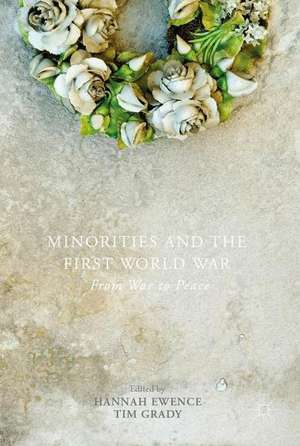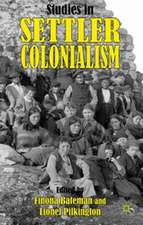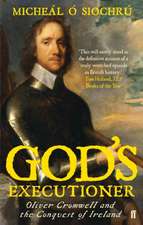Minorities and the First World War: From War to Peace
Editat de Hannah Ewence, Tim Gradyen Limba Engleză Hardback – 5 sep 2017
The first section discusses so-called ‘friendly minorities’, considering the way in which Jews, Muslims and refugees lived through the war and its aftermath. Section two looks at fears of ‘enemy aliens’, which prompted not only widespread internment, but also violence and genocide. The third section considers how the wartime experience of minorities played out in interwar Europe, exploring debates over political representation and remembrance. Bridging the gap between war and peace, this is the ideal book for all those interested in both First World War and minority histories.
Preț: 700.61 lei
Preț vechi: 824.25 lei
-15% Nou
Puncte Express: 1051
Preț estimativ în valută:
134.07€ • 138.52$ • 111.53£
134.07€ • 138.52$ • 111.53£
Carte tipărită la comandă
Livrare economică 19 martie-02 aprilie
Preluare comenzi: 021 569.72.76
Specificații
ISBN-13: 9781137539748
ISBN-10: 1137539747
Pagini: 304
Ilustrații: X, 300 p.
Dimensiuni: 148 x 210 x 22 mm
Greutate: 0.52 kg
Ediția:2017
Editura: Palgrave Macmillan UK
Colecția Palgrave Macmillan
Locul publicării:London, United Kingdom
ISBN-10: 1137539747
Pagini: 304
Ilustrații: X, 300 p.
Dimensiuni: 148 x 210 x 22 mm
Greutate: 0.52 kg
Ediția:2017
Editura: Palgrave Macmillan UK
Colecția Palgrave Macmillan
Locul publicării:London, United Kingdom
Cuprins
1. Introduction. Minority History: From War to Peace; Hannah Ewence and Tim Grady.- Part One: “Friendly” Minorities in War and Peace.- 2. Tasting the King’s Salt: Muslims, Contested Loyalties and the First World War; Humayun Ansari.- 3. Between Friends and Enemies: The Dilemma of Jews in the Final Stages of the War; Sarah Panter.- 4. Bridging the Gap between ‘War’ and ‘Peace’: The Case of Belgian Refugees in Britain; Hannah Ewence.- Part Two: “The Wartime “Enemy”: From Internment to Freedom.- 5. ‘Enemy Aliens’ in Scotland in a Global Context, 1914-1919: Germanophobia, Internment, Forgetting; Stefan Manz.- 6. The Enemy Within?: Armenians, Jews, the Military Crises of 1915 and the Genocidal Origins of the ‘Minorities Question’; Mark Levene.- 7. Black, Arab and South Asian Colonial Britons in the Intersections between War and Peace: The 1919 Seaport Riots in Perspective; Jacqueline Jenkinson.- Part Three: Remembering and Forgetting Minoritiesin Wartime.- 8. Race and the Legacy of the First World War in French Anti-Colonial Politics of the 1920s; David Murphy.- 9. Memory, Storytelling and Minorities: A Case Study of Jews in Britain and the First World War; Tony Kushner.- 10. Selective Remembering: Minorities and the Remembrance of the First World War in Britain and Germany; Tim Grady.- 11. Afterword; Panikos Panayi
Notă biografică
Hannah Ewence is Senior Lecturer in History at the University of Chester, UK. She is the co-editor of Whatever Happened to British-Jewish Studies? (2012) and Visualizing Jews through the Ages: Literary and Material Representations of Jewishness and Judaism (2015).
Tim Grady is Reader in Modern History at the University of Chester, UK. He is the author of German Jews and the First World War in History and Memory (2009), as well as the forthcoming book: A Deadly Legacy: German Jews and the Great War (2017).
Textul de pe ultima copertă
This book examines the particular experience of ethnic, religious and national minorities who participated in the First World War as members of the main belligerent powers: Britain, France, Germany and Russia. Individual chapters explore themes including contested loyalties, internment, refugees, racial violence, genocide and disputed memories from 1914 through into the interwar years to explore how minorities made the transition from war to peace at the end of the First World War.
The first section discusses so-called 'friendly minorities', considering the way in which Jews, Muslims and refugees lived through the war and its aftermath. Section two looks at fears of 'enemy aliens', which prompted not only widespread internment, but also violence and genocide. The third section considers how the wartime experience of minorities played out in interwar Europe, exploring debates over political representation and remembrance, thereby bridging the gap between war and peace.
The first section discusses so-called 'friendly minorities', considering the way in which Jews, Muslims and refugees lived through the war and its aftermath. Section two looks at fears of 'enemy aliens', which prompted not only widespread internment, but also violence and genocide. The third section considers how the wartime experience of minorities played out in interwar Europe, exploring debates over political representation and remembrance, thereby bridging the gap between war and peace.
Caracteristici
Examines the experience of ethnic, religious and national minorities participating in the First World War Explores issues of contested loyalties, internment, refugees, racial violence, genocide, and memory Departs from existing narratives of the Great War and develops alternative ways of thinking about the conflict












